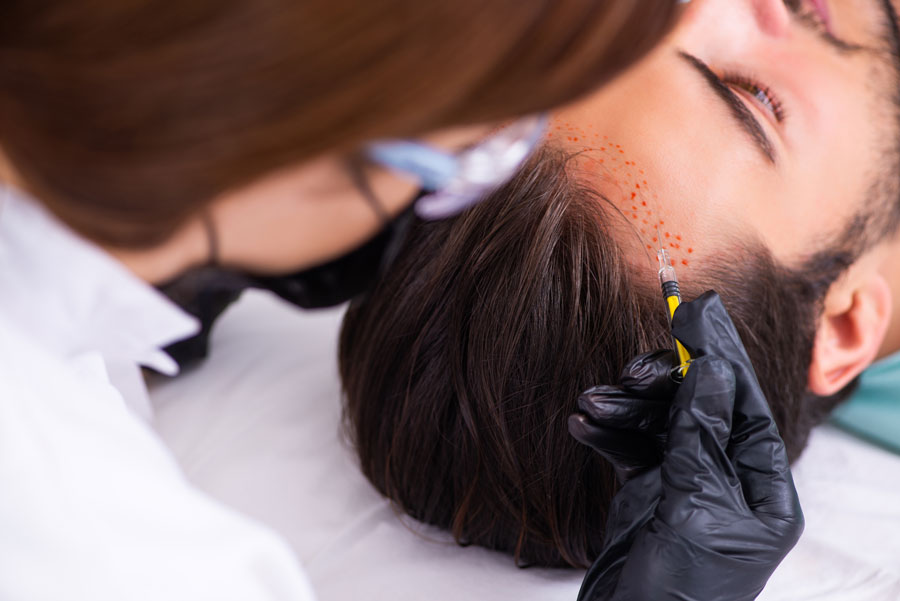Hair loss can be a stressful experience that affects your appearance and your self-perception. At Ridenour Plastic Surgery, we understand the impact of hair loss and offer cutting-edge solutions that go beyond traditional methods. Whether you’re facing thinning hair or more significant hair loss, our suite of advanced hair restoration treatments can revitalize your hair’s natural growth and appearance.
Hair Loss Treatments at Ridenour Plastic Surgery
At our St. Louis plastic surgery practice, we offer the following hair restoration treatments:
- Nonsurgical hair regeneration, which includes:
- Genomic testing (DNA) to determine the best medical treatment (oral and topical)
- Nanofat (adipose-derived-stem-cell) injections
- Microneedling with exosome application
- Topical exosome therapy
- Eyebrow and eyelash transplants
Let’s explore how these innovative therapies work to restore your hair to its former glory.
How Does Regenerative Medicine Work for Hair Restoration?
Regenerative medicine provides a revolutionary approach to treating hair loss. This treatment leverages your body’s healing to stimulate hair growth. It involves harvesting the following elements from your blood and then applying them to your scalp or other areas of hair loss:
- Growth factors
- Stem cells
- Cytokines
- Exosomes
What Are Growth Factors?
Growth factors are naturally occurring proteins that play critical roles in cellular growth, proliferation and healing. In the context of hair restoration, growth factors such as Vascular Endothelial Growth Factor (VEGF), Fibroblast Growth Factor (FGF) and Platelet-Derived Growth Factor (PDGF) are of particular importance.
What Do Growth Factors Do?
These essential proteins help to:
- Stimulate angiogenesis: Growth factors like VEGF promote the formation of new blood vessels around the hair follicles. This process, known as angiogenesis, is crucial for delivering oxygen and nutrients to the hair follicles, creating an optimal environment for hair growth.
- Promote cellular proliferation: PDGF and FGF contribute to the proliferation of cells within the hair follicle, encouraging the follicles to enter and sustain the anagen (growth) phase of the hair cycle. This prolongs the period of active hair growth.
- Enhance follicular health: By promoting the health and vitality of hair follicles, growth factors strengthen the existing hair and support new hair growth.
What Are Stem Cells?
Stem cells, particularly those found in fat (adipose) tissue or derived from the blood (mesenchymal stem cells), are pivotal in regenerative hair treatments. They have the unique ability to differentiate into various cell types, including those critical for hair follicle regeneration.
What Do Stem Cells Do?
When introduced to the scalp, stem cells:
- Foster a regenerative environment: By secreting various growth factors and cytokines, stem cells create a supportive environment that facilitates hair follicle recovery and growth.
- Stimulate hair follicle cells: They directly contribute to the regeneration of hair follicle cells, encouraging them to transition from the telogen (resting) phase back into the anagen phase.
What Are Cytokines?
Cytokines are signaling proteins that mediate and regulate immunity, inflammation and hematopoiesis.
What Do Cytokines Do?
When it comes to hair restoration, the role of cytokines is multifaceted:
- Modulate immune response: Certain cytokines can help reduce inflammation around the hair follicles, which is often associated with various forms of hair loss.
- Enhance cellular communication: They facilitate communication between cells, ensuring that the regenerative processes are synchronized and effective in promoting hair growth.
- Support tissue repair: By influencing cellular behavior, cytokines aid in the repair and regeneration of tissue, including the hair follicles, enhancing their ability to produce hair.
When applied to the scalp, these growth factors, stem cells and cytokines work together to promote new hair growth and strengthen existing hair follicles, making your hair appear fuller and healthier.
How Does Nanofat Hair Restoration (Nanofat Injections) Work?
Nanofat transfer, also known as nanofat grafting, represents a significant breakthrough in combating hair loss. It uses processed fat from your body to encourage hair growth. The process begins with a gentle liposuction to extract a small amount of fat, typically from the abdomen or thighs. This fat is then meticulously processed to isolate the regenerative cells it contains.
The resulting nanofat is rich in stem cells and growth factors, similar to those used in regenerative medicine. When injected into the scalp, these cells support and enhance the natural repair processes of hair follicles, encouraging new hair growth and improving the health of the scalp.
Nanofat Transfer Promotes Hair Growth By:
- Activating follicular regeneration: Stimulating dormant hair follicles to enter the growth phase
- Enhancing nutrient supply: Improving blood flow to provide follicles with essential nutrients and oxygen
- Reducing inflammation: Modulating the scalp’s immune response to create a healthier environment for hair growth
- Promoting cellular communication: Facilitating the exchange of signals that encourage hair follicle development and growth
- Increasing hair density: Supporting the proliferation of hair follicle cells to increase overall hair density
- Improving scalp health: Contributing to the overall health of the scalp, creating an optimal environment for hair growth
- Extending the growth phase: Keeping hair follicles in the growth phase longer, resulting in longer, thicker hair strands
How Does Topical Exosome Therapy Work for Hair Restoration?
Topical exosome therapy has garnered attention in the field of hair restoration for its innovative use of exosomes in treating hair loss. These exosomes (which are extracellular vesicles derived from platelets, adipose stem cells and mesenchymal stem cells) have emerged as key players in cellular communication and regenerative medicine. Here’s a closer examination of how exosomes combat hair loss:
Exosome Composition and Function
- Rich in biomolecules: Exosomes are packed with a diverse array of proteins, lipids and nucleic acids (including mRNA and microRNA). This unique composition enables them to influence various biological processes.
- Cellular communication: They facilitate intercellular communication by transferring their cargo between cells. This ability is crucial in modulating recipient cells’ activities to promote hair growth and follicle health.
Mechanisms in Hair Restoration
- Stimulating follicular regeneration: Exosomes carry growth factors and cytokines that directly stimulate hair follicles to enter the growth phase from the resting phase, thus promoting hair growth.
- Enhancing angiogenesis: By delivering pro-angiogenic factors, exosomes promote the formation of new blood vessels around the hair follicles. This increased vascularization provides an ample supply of oxygen and nutrients, which is vital for healthy hair growth.
- Regulating the hair growth cycle: Exosomes can influence the hair growth cycle by modulating the expression of genes involved in hair follicle development and cycling. This helps prolong the growth phase and delays the transition to the resting phase.
- Anti-inflammatory effects: They possess anti-inflammatory properties that can help reduce scalp inflammation, a condition often associated with hair loss. By moderating immune responses, exosomes create a healthier scalp environment conducive to hair growth.
- Modulating immune responses: Exosomes can alter immune cell behavior, which is particularly beneficial in autoimmune forms of hair loss, such as alopecia areata, by preventing immune cells from attacking hair follicles.
- Enhancing cellular survival and proliferation: The microRNAs within exosomes can regulate cell survival and proliferation pathways, ensuring the vitality and growth of hair follicle cells.
Topical exosome therapy represents a cutting-edge approach to treating hair loss, offering a novel mechanism that leverages the body’s cellular communication systems to promote hair growth.
How Do Eyebrow and Eyelash Hair Transplants Work?
Eyebrow and eyelash transplants are specialized forms of hair restoration tailored to these delicate areas. Using techniques similar to follicular unit grafting, individual hair follicles are transplanted to the eyebrows or eyelashes. This meticulous procedure allows for restoring these features to their natural fullness and shape.
Eyebrow and eyelash transplants require a high level of expertise to ensure that the transplanted hairs blend seamlessly with the existing hairs, achieving a natural and aesthetically pleasing result. These treatments can dramatically enhance your facial features, offering a virtually permanent solution to thinning eyebrows and eyelashes.
Hair Maintenance With Oral and Topical Medication
No matter what treatment we determine is best for you — PRP injections, microneedling with topical exosomes, nanofat injections or hair grafts — it is important to maintain hair growth with proper medical therapy.
At Ridenour Aesthetics, we determine the best combination of topical and oral medications to keep your hair growing strong. Like fertilizer for plants, the precise combination of medications in ideal dosages gives your hair the best environment to grow and thrive. Medications we offer include minoxidil, dutasteride, finasteride, latanoprost and spironolactone among many others. Supplements like biotin, iron, magnesium and zinc are also important for hair growth.
In order to determine the best personalized approach to medication, we employ the TrichoTest™ in our practice. TrichoTest is a genetic test for hair loss that evaluates genetic variations and lifestyle elements to recommend tailored hair loss treatments. A simple cheek swab is performed in-office along with a detailed health questionnaire. Your DNA is analyzed, and specific recommendations for treatment are returned in a detailed report.
Studies confirm a link between your genetic makeup and your response to various hair loss treatments. This suggests that the effectiveness of hair loss solutions varies from person to person, influenced by individual genetic and lifestyle factors.
Why Choose Ridenour Plastic Surgery for Hair Restoration?
At Ridenour Plastic Surgery, we pride ourselves on offering the latest advancements in hair restoration. Our team of experts is committed to providing personalized care, ensuring that each treatment plan is tailored to meet your unique needs and goals. With our state-of-the-art techniques and a focus on natural-looking results, we strive to restore your hair and your confidence in your appearance.
If you’re exploring options for hair restoration, schedule your consultation online or call us at (314) 878-8600 to learn more about how these innovative treatments can help you achieve the full, healthy hair you desire.



